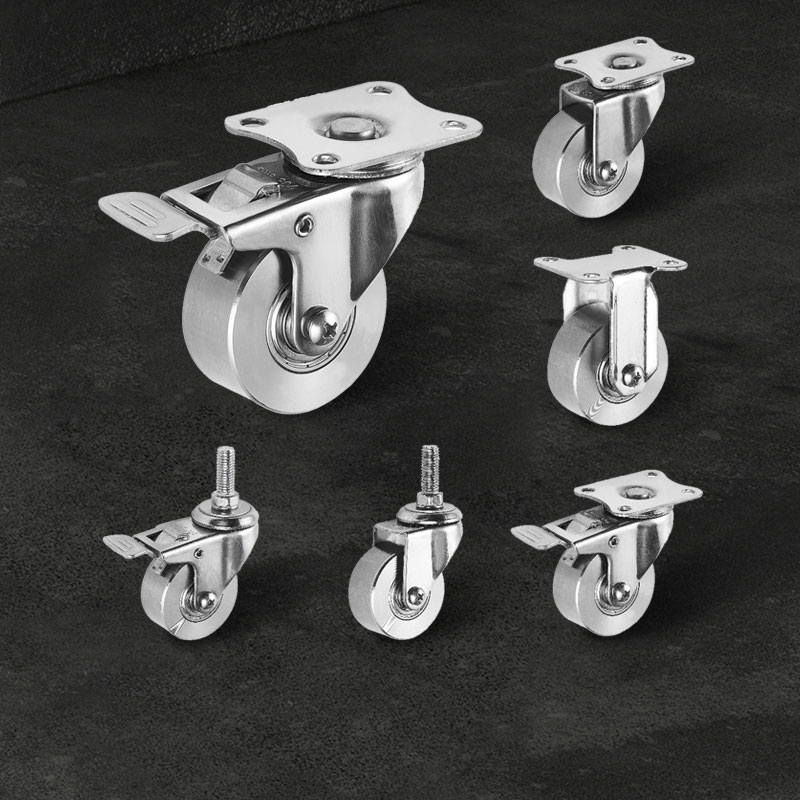In the world of material handling and mobility solutions, casters play a yet critical role in ensuring efficiency, safety, and durability across countless industries. Among the various types of casters available, stainless steel casters have emerged as a preferred option for environments where strength, corrosion resistance, and hygiene are non-negotiable. From food processing plants and medical facilities to industrial warehouses and outdoor settings, these casters provide a reliable foundation for moving heavy loads while withstanding harsh conditions. But what sets high-quality stainless steel casters apart, and why are they indispensable in specific applications? This guide delves into the unique benefits of stainless steel casters, highlights key features to consider when selecting them, details the specifications of our top-tier products, and addresses common questions to help businesses make informed decisions.
Unmatched Corrosion Resistance
One of the most significant advantages of stainless steel casters is their resistance to corrosion, rust, and chemical damage. This is due to the chromium content in stainless steel, which forms a protective oxide layer on the surface, preventing moisture, acids, and harsh chemicals from penetrating the material. In environments where water, cleaning agents, or corrosive substances are prevalent—such as food processing plants (where daily washdowns with sanitizers are required), pharmaceutical facilities, or outdoor settings exposed to rain and humidity—stainless steel casters maintain their structural integrity. In contrast, casters made from mild steel or iron would quickly rust, weaken, and fail under such conditions, leading to frequent replacements and operational disruptions. For businesses in these sectors, stainless steel casters reduce maintenance costs and ensure long-term reliability.
Compliance with Hygiene Standards
Industries like food and beverage, healthcare, and pharmaceuticals are governed by strict hygiene regulations to prevent contamination and ensure product safety. Stainless steel casters are non-porous, smooth, and easy to clean, making them inherently resistant to bacterial growth. Unlike casters with crevices, painted surfaces, or porous materials (which can trap dirt, moisture, and pathogens), stainless steel casters can be thoroughly sanitized with high-pressure washers, steam cleaners, or chemical disinfectants without damage. This feature is critical in environments where even minor contamination could lead to product recalls, health risks, or regulatory penalties. For example, in a commercial kitchen, stainless steel casters on food carts or equipment can be cleaned daily to meet FDA or EU food safety standards, ensuring a hygienic workspace.
Exceptional Strength and Load-Bearing Capacity
Stainless steel is renowned for its high tensile strength, making stainless steel casters capable of supporting heavy loads without bending, warping, or breaking. Depending on their design and size, these casters can handle load capacities ranging from 100 kg to over 1,500 kg per caster, making them suitable for industrial equipment, heavy machinery, and large storage racks. This strength is particularly valuable in manufacturing facilities, warehouses, and logistics centers, where moving heavy items efficiently is essential for productivity. Unlike plastic or rubber casters, which may crack or deform under heavy loads, stainless steel casters maintain their performance over time, reducing the risk of equipment failure and workplace accidents.
Temperature Resistance
Stainless steel casters excel in environments with extreme temperatures, whether high heat or cold. They can withstand exposure to hot water, steam, or high-temperature cleaning processes (common in food processing and healthcare) without melting, warping, or losing structural integrity. Similarly, in cold storage facilities (e.g., freezers in food distribution centers), stainless steel casters resist brittleness and remain functional, whereas plastic casters might become rigid and crack in low temperatures. This temperature versatility ensures that stainless steel casters perform reliably in diverse settings, from industrial ovens to cold storage units.
Longevity and Cost-Effectiveness
While stainless steel casters may have a higher upfront cost compared to casters made from cheaper materials, their longevity and low maintenance requirements make them more cost-effective in the long run. In corrosive or high-use environments, mild steel or plastic casters may need replacement every few months, whereas stainless steel casters can last for years—even decades—with minimal upkeep. This reduces downtime associated with frequent replacements, lowers procurement costs over time, and minimizes the total cost of ownership. For businesses looking to invest in durable, long-lasting equipment, stainless steel casters offer a clear return on investment.
Type of Stainless Steel
Not all stainless steel is created equal. The most common grades used in caster manufacturing are 304 and 316 stainless steel:
|
Feature
|
Light-Duty Stainless Steel Caster (CL-SS100)
|
Heavy-Duty Stainless Steel Caster (CL-SS500)
|
Ultra-Corrosion-Resistant Caster (CL-SS800)
|
|
Stainless Steel Grade
|
304
|
304 (316 option available)
|
316
|
|
Wheel Material
|
Polyurethane (PU)
|
Nylon
|
Stainless Steel
|
|
Wheel Diameter
|
4 inches / 100mm
|
8 inches / 200mm
|
6 inches / 150mm
|
|
Wheel Width
|
1.5 inches / 38mm
|
2.5 inches / 63mm
|
2 inches / 50mm
|
|
Load Capacity (per caster)
|
150 kg
|
800 kg
|
500 kg
|
|
Swivel Radius
|
3.5 inches / 89mm
|
6 inches / 152mm
|
5 inches / 127mm
|
|
Brake Type
|
Wheel lock
|
Total lock
|
Total lock with stainless steel hardware
|
|
Temperature Resistance
|
-30°C to 80°C
|
-40°C to 120°C
|
-50°C to 150°C
|
|
Bearing Type
|
Precision ball bearings
|
Double-sealed roller bearings
|
Stainless steel ball bearings
|
|
Mounting Type
|
Top plate (4" x 4")
|
Top plate (6" x 6")
|
Top plate (5" x 5") or stem mount
|
|
Applications
|
Medical carts, food service trolleys, light equipment
|
Industrial machinery, heavy storage racks, warehouse equipment
|
Marine environments, chemical processing, outdoor use
|
|
Compliance
|
FDA, EU 10/2011 (food contact)
|
ISO 9001, OSHA standards
|
NSF, FDA, marine industry standards
|
|
Warranty
|
2 years
|
3 years
|
5 years
|
All our casters undergo rigorous testing, including load-bearing trials, corrosion resistance tests, and brake performance checks, to ensure they meet or exceed industry standards. We also offer customization options, such as stem mounts or specialized wheel materials, to tailor casters to specific application needs.



